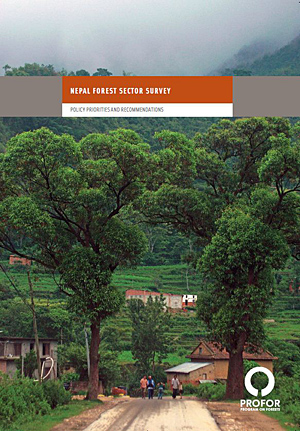
Share
Related Links
Attachments
NepalForestSector-Survey-Dec2013_0_0.pdf
Keywords
Authors/Partners
William B. Magrath, Ashish Shrestha, Bhishma Subedi, Hari Dansha Dulal, and Rex Baumback
Nepal Forest Sector Survey
CHALLENGE
Nepal's diverse landscape is divided into three main regions: the Upper Hills, the Middle Hills and the Terai, each presenting different forestry management challenges. Overall, the country has experienced significant losses in forest cover, with forest conversion to shrub land at 5.6% on aveagre oer year. While community forestry programs have had a successful impact on forest cover in the Middle Hills, higher altitude terrain has been difficult to manage and monitor. In Nepal's lowlands (the Terai region), demographic pressure, uneven distribution of high-value forest resources, easy road access and a porous border with India have created a challenging environment where innaprorpriate timber extraction, illegal encorachment and logging and poor management of protected areas and watersheds are constraining the potential of forestry to improve livelihoods, conservation and sustainable economic growth.
Achieving sustainable forest management in this region, where the major proportion of Nepal's forest loss is occurring, is a major and urgent challenge that needs to be addressed if national level REDD processes are to yield any benefits for Nepal.
APPROACH
With PROFOR support, the World Bank’s South Asia region conducted an analysis of the the forest sector in Nepal that provides policy priorities and recommendations to the Ministry of Forestry and Soil Conservation and other audiences, to improve mechanisms for resource mobilization in forestry, incentives, and governance.
RESULTS
The survey was published in November 2013. It is available for download on this page. It outlines the following key priorities for Nepali forestry sector reform:
- Remain committed to community-based approaches and minimize discrepancies in benefit sharing arrangements.
- Develop multisector, multistakeholder land use planning to rationalize and prioritize land conversions.
- Pursue remedies against corruption and criminal allegations and adopt a risk-based approach to prevent forest crime.
- Rationalize forest administration to address excessive costs and improve resource management.
- Reform the timber marketing system by liquidating Timber Corporation of Nepal and introduce market-based timber sales based on transparent harvest planning and controls.
For stories and updates on related activities, follow us on twitter and facebook , or subscribe to our mailing list for regular updates.
Author : William B. Magrath, Ashish Shrestha, Bhishma Subedi, Hari Dansha Dulal, and Rex Baumback
Last Updated : 06-16-2024








